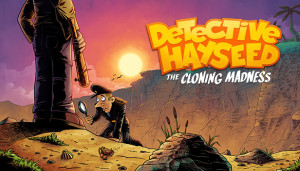Review for Ghost In The Mirror: Episode 1 — Here Be Dragons

Sui Arts’ Ghost In The Mirror: Episode I — Here Be Dragons is the first chapter in a series of episodic adventures. This first offering valiantly seeks to tell an entertaining story. There are plenty of things to like about it. Firstly, there’s the hilariously written pirate tale that isn’t afraid to poke fun at itself — an amusing narrative that births many zany and challenging puzzles. Secondly, the beautifully crafted pixel-art graphics, and well-animated characters. Thirdly, the lively, charming music. However, certain players may be frustrated by the way interaction is handled. Before players can immerse themselves in this adventure using a fairly simple combination of the keyboard and mouse, they must contend with a frustrating main menu. Additionally, the narrative contains mini-games that lack clear instructions and may be difficult for those with slow reflexes. Yet if players are prepared to gird themselves with patience, they will experience a whimsically engaging game.
The funny story will spark a reaction in even the most serious player. Roger, a criminal, is on the run. He happens upon a village where he schemes to get a meal at the town’s inn. Many adventures start with a mundane task such as this one. Yet this specific quest for a meal is particularly memorable because the “fourth wall” that separates players from the tale in which they are participating is completely shattered. Roger knows he’s in a game. He knows the player is playing and he knows that Sui, the designer, has crafted his world. An exchange between Sui (the designer), and Roger (his creation), sets the stage for the entire adventure. Roger asks: “So, does this village have a name? Something like Ghost Pirate Island?” and Sui replies: “I don’t know, I didn’t think about it…” Roger persists: “But there will be ghosts and pirates eventually, right?” Sui dodges Roger’s question: “You’re only at the beginning of the game…I don’t want to spoil it.” Roger’s frustrated response is: “I think you don’t even know what you are doing…” For me, this exchange elicited the first of many smiles.
The droll dialogs and humorous plot provide the foundation for intriguing puzzles. My favorite involves plundering a smuggler's cave for a needed item. The player uses the mouse to manipulate pyramids so that segments of the picturesque artwork match, forming one splendid image. The cave entrance opens when the player succeeds.
The pyramid pictures are just one example of the superior graphics in this game. The eerie pixel art grabs players and pulls them in. I loved the mysterious green forest and the comically drawn seagulls that populate the sky. (I grinned when the gulls left “gifts” on Roger's head.) This spooky, lovingly drawn world is home to many animated characters; I particularly admired Roger’s purposeful strides while walking and running.
Ghost In The Mirror: Episode I — Here Be Dragons also doesn’t neglect players’ ears while showing off its visuals. The soundtrack is amusingly bouncy with a rapid tempo, especially in the town. It subconsciously reinforces the urgency of Roger’s goals while balancing them with an irreverent tune. There’s no voice acting but its absence didn’t diminish my enjoyment.
However, I was frustrated by the way this game handled its interactive elements. Directing Roger within the gameworld via the WASD controls works reasonably well. The W key tilts the camera up and S tilts it down. Holding the left-shift button in addition to a direction key compels Roger to run in the indicated direction. When he moves close to an item or character, a dot appears above his head which signifies that he can interact by pressing E. Doing so when near an item adds it to inventory. According to the tutorial, the hand icon in the lower-left corner also governs interaction. When you click on it, a small white light appears, and Roger will follow it as long as you hold down the left mouse button. How this affects interactions is somewhat confusing.
Fortunately, using an item is simple. After clicking on the bag icon in the upper-left corner, the player selects an object using the mouse and presses E to activate it. If a key is selected while standing near a door, Roger will attempt to unlock the door, and will inform the player of success or failure via text at the top of the screen. If an item is selected near a character, Roger will give them the object. The inventory contains a helpful task list, a hint system, and even a walkthrough video.
The E button is very useful. Besides grabbing and using items, it controls conversations. Using it near a character will bring up a list of chat options. After selecting one, the conversation unfolds at the top of the screen. There are no manual saves; progress is saved automatically when exiting the program. The controls during gameplay work well enough, but the main menu is a different matter.
The main menu is perplexing due to inadequate instructions. The player starts out looking through a lit window at the inside of a house. Upon entering, you stand in front of a first-person view of the designer’s desk. After a short introduction, the word “Play” plasters itself across the screen. Pressing “Play” obviously starts the game. However, when the time came for me to take a break, I couldn’t figure out how to exit the program. It turns out that the inside of the house that you first encounter actually constitutes the main menu. The desk includes the “Play” option and “Settings” are located in the fireplace. Through trial and error, I discovered that the menu moves clockwise through the various selections if you click on the upper-left corner of the screen. After spending a long time clicking through a multitude of options, I finally realized that you have to click on the back door to exit the program. This game would definitely benefit from a set of clearly written directions.
Some of the mini-games also demand better explanations. For instance: in the pick-pocketing challenge, you need to steal two items, and Roger only advises you that a steady hand is needed. Pilfering them successfully requires more than that; if you fail by moving the mouse incorrectly, the mini-game will reset. After many attempts I succeeded through sheer luck.
Ghost In The Mirror: Episode I — Here Be Dragons provides a satisfactory experience with lots of potential, including a witty story that players will savor. Its confusing main menu and eccentric mini-games may cause frustration for some players due to vague instructions. Players should employ patience to maximize their enjoyment.











__medium.jpeg)













